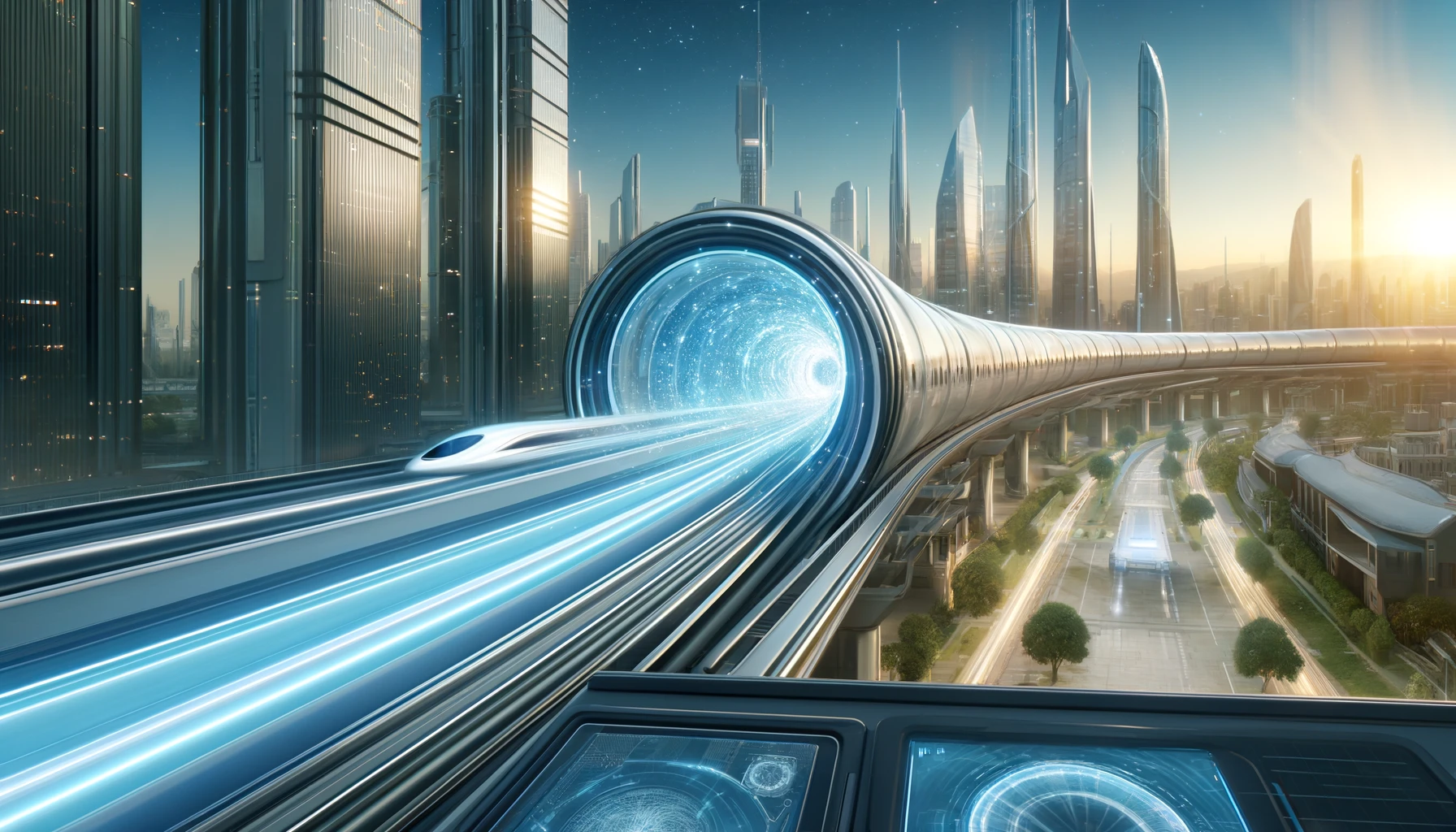Imagine travelling from London to New York in minutes or even seconds. Ultra-high-speed travel, including teleportation, could transform connectivity, slash emissions, and revolutionise industries. Let’s explore this bold frontier.
SUMMARY
The Problem: Modern travel systems are slow, inefficient, and environmentally costly.
The Solution: Develop ultra-high-speed travel technologies, including advanced maglev systems, hyperloops, and, eventually, teleportation. This will radically transform global mobility, reduce travel times to seconds, and significantly cut carbon emissions.
Stakeholders: Governments, transportation companies, technology developers, and global citizens. A coordinated approach will be essential to overcoming barriers to adoption.
CONTEXT
The demand for faster, more sustainable travel systems has never been greater. Current modes of transport are limited by infrastructure, energy inefficiencies, and environmental impact. Airplanes, the fastest existing mode of long-distance travel, emit significant CO₂, contributing to climate change. With growing globalisation, the pressure to innovate is immense. Ultra-high-speed systems offer a future where distance is no longer a barrier to human interaction or economic development.
CHALLENGES
Technological barriers
- High-speed infrastructure: Current transport systems cannot support speeds exceeding 700 mph sustainably.
- Teleportation physics: Viable quantum transportation remains theoretical, requiring breakthroughs in quantum entanglement and matter reconstruction.
Economic constraints
- Enormous costs for research, testing, and infrastructure development.
- High upfront investment for unproven technologies.
Regulatory and societal concerns
- Safety issues surrounding teleportation and ultra-high-speed systems.
- Potential resistance to job displacement and social upheaval.
Environmental impact
- Balancing high-speed innovation with minimal ecological disruption.
GOALS
- Short-term: Develop commercial ultra-high-speed maglev and hyperloop systems capable of 1,000 mph travel by 2030.
- Long-term: Achieve operational teleportation for humans and goods by 2050.
STAKEHOLDERS
- Governments: Regulatory approval, public funding, and infrastructure development.
- Private sector: Engineering expertise, investment in R&D, and scaling technologies.
- Academia: Breakthroughs in quantum physics, materials science, and AI.
- Citizens: Adoption of the new systems and shaping public discourse.
SOLUTION
1. Developing Advanced Maglev and Hyperloop Systems
What it involves:
High-speed maglev (magnetic levitation) trains already exist but are limited in speed (~375 mph). Next-generation designs aim for speeds exceeding 600 mph by reducing drag through evacuated tubes (hyperloops).
Challenges it addresses:
- Faster commutes and logistics.
- Energy-efficient alternatives to air travel.
Innovation:
- Electrodynamic suspension (EDS) maglev systems.
- Renewable energy-powered hyperloop infrastructure.
Scalability:
- Integrate hyperloop systems into urban hubs worldwide to connect major economic centres.
Sustainability:
- Renewable energy sources (solar, wind) for propulsion.
- Low-emission construction materials.
Cost:
Estimated $500 billion for global hyperloop deployment over 10 years.
2. Quantum Teleportation Research
What it involves:
Teleportation leverages quantum entanglement to transmit information and eventually matter instantaneously. Current experiments have succeeded in transferring quantum states over short distances.
Challenges it addresses:
- Overcomes the limitations of physical travel.
- Eliminates the need for conventional transport infrastructure.
Innovation:
- Quantum processors for precise state replication.
- Advanced algorithms for encoding and decoding complex data structures.
Scalability:
- Develop pilot systems for material transfer before scaling for human use.
- Establish teleportation networks akin to the internet, with teleportation “nodes.”
Sustainability:
- Zero-carbon mode of travel, aside from infrastructure energy use.
Cost:
Initial R&D investment of $50 billion over 15 years.
3. Autonomous Safety and Control Systems
What it involves:
AI-driven safety protocols will manage ultra-high-speed travel systems. These include predictive maintenance, route optimisation, and collision avoidance.
Challenges it addresses:
- Mitigates safety risks inherent in high-speed systems.
- Builds public trust in innovative travel technologies.
Innovation:
- Quantum AI for instantaneous decision-making.
- Blockchain for secure, transparent transportation data.
Scalability:
AI systems can be replicated across travel systems globally with local customisation.
Sustainability:
- Efficient resource usage through predictive analytics.
Cost:
$20 billion for global AI deployment in the next decade.
4. Public Engagement and Infrastructure Development
What it involves:
Governments and private firms will lead infrastructure expansion and public engagement campaigns to encourage adoption.
Challenges it addresses:
- Public hesitancy and regulatory barriers.
- Coordination between sectors.
Innovation:
- Immersive VR demonstrations to showcase safety and benefits.
- Crowdsourced design competitions for local integration.
Scalability:
- Modular infrastructure systems for rapid deployment worldwide.
Sustainability:
- Aligns with smart city initiatives, reducing urban congestion.
Cost:
$150 billion for global deployment and community engagement programmes.
IMPLEMENTATION
Timeline:
- Year 1-5: Hyperloop and advanced maglev prototypes; teleportation feasibility studies.
- Year 5-10: Commercial rollout of hyperloop systems; human teleportation trials.
- Year 10-25: Global hyperloop infrastructure; initial human teleportation systems operational.
Resources Needed:
- Human: 50,000 engineers, scientists, and construction workers globally.
- Financial: $720 billion total budget.
- Technological: Advanced quantum computers, superconducting materials, and renewable energy sources.
Risk Mitigation:
- Rigorous safety testing and fail-safe mechanisms for teleportation systems.
- Contingency funds for unforeseen technical challenges.
Monitoring Framework:
Regular audits and independent evaluations of progress every five years.
FINANCIALS
| Element | Cost ($B) | Funding Sources |
|---|---|---|
| Hyperloop systems | 500 | Public-private partnerships, carbon credits. |
| Quantum teleportation R&D | 50 | Tech billionaires, defence grants, international research funds. |
| AI safety/control systems | 20 | Tech firms, venture capital. |
| Public engagement/infrastructure | 150 | Crowdfunding, philanthropic donations, sovereign wealth funds. |
| Total | 720 |
CASE STUDIES
- Hyperloop Prototypes: Virgin Hyperloop has successfully tested high-speed travel systems. Lessons include focusing on passenger comfort and safety.
- Quantum Achievements: China’s Micius satellite demonstrated quantum communication over 1,200 km, showcasing progress in teleportation precursors.
IMPACT
Quantitative Outcomes:
- Reduce intercontinental travel times by 95%.
- Cut transportation emissions by 80% by 2050.
Qualitative Outcomes:
- Foster greater global connectivity and economic cooperation.
- Spark technological advancements in other fields (e.g., computing, energy).
Broader Benefits:
- Strengthen the fight against climate change.
- Reduce inequality by connecting remote regions to global hubs.
CALL TO ACTION
The vision of ultra-high-speed travel demands bold action. Governments must allocate funding, the private sector must embrace innovation, and citizens must advocate for transformative solutions. Let’s reimagine what’s possible—starting today.

Leave a Reply